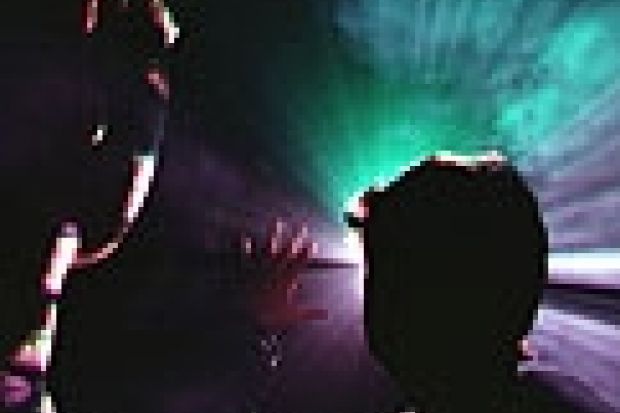Trainee stage managers get the chance to use cutting-edge equipment in an unusual college-industry link. Olga Wojtas catches the pyrotechnics.
Pyrotechnics and light shows are as close to rock and roll as it gets for trainee stage managers at Queen Margaret University College drama school. But backstage at the drab college theatre, amid ugly cables and consoles, it seems unlikely. The students are eager, though, as is George Tarbuck, their lighting and sound lecturer, who has organised a weekend workshop sponsored by moving light supplier Vari-Lite and pyrotechnics company Le Maitre.
"Lighting should be fun," says Tarbuck. "If it's not, then go work in a bank. The hours are far more sane and you might get a life."
The 14 students find the technology awesome. They crowd around the lighting and control consoles as Carol Cooper, education manager for Vari-Lite, gives a light show to Peer Gynt .
The dingy theatre is transformed by a breathtaking display of colours and patterns while a hazer machine blows a fine film of cracked oil into the air. "It helps enhance the beams of light," Cooper explains. "Otherwise it's a little bit flat." The show is not spontaneous - a virtual version is created first. "This allows you to programme the show before you get anywhere near the venue, so you save a lot of money on production time," Cooper says.
The students are split into three groups and given 90 minutes to structure a 90-second light show. Andrew Coulton, a second-year student, estimates that during the 90 seconds, there will have to be 20 cues to change the lights, with decisions having to be made about colour, shape, pattern, and sharpness of the focus.
"You've got to translate that to numeric values on the lighting desk to control it. Even a professional lighting designer on their own would probably (take) six or seven minutes per cue," he says. "The amount of work that goes into large-scale moving lights is very time consuming. At the Olympic Games, there were 14 technicians working 12 hour shifts for four weeks to produce an hour and three-quarters of lighting for the opening sequence."
The pyrotechnics element of the workshop is less arduous. Paul McGreal, project manager of Scottish lighting company black light, has no intention of allowing the students hands-on experience. "These things are dangerous, and as a result, there's legislation governing how and where we can use them. There was an idiot reported recently dicking about with maroons, who blew his hands off," he says.
"Before you place your pyros, a risk assessment is necessary. Some of these things have hot particles, showers of sparks. You need to consider how to exclude people from the firing zone. Always keep a distance between you and the pyro. You need to be sure you have a clear line of sight. Don't rely on closed-circuit TV or the stage manager - if you can't see, don't fire, end of story. If a pyro misfires, leave it for 15 minutes in the pod, because possibly the fuse is still burning."
Technicians have a duty to ensure equipment does not fall into the wrong hands, he says. Theatrical pyrotechnics were used in a spate of firebombings last year by animal rights activists and feature in the Anarchist Cookbook . "Bizarrely, you're allowed to store them in wooden containers. I wouldn't advise that. Use a steel box," McGreal says.
He urges the students not to remove the key switch from the firing system until the last moment, keeping the key with them. He also unplugs the cable and the mains. Fire extinguishers are strategically placed, and two doors have been blocked off to prevent the unwary wandering into the line of fire.
McGreal demonstrates how to load the pyrotechnics, and then sets off a column of silver sparks, followed by a mushroom cloud of golden stars, a flash and smoke effect for a genie, a thick plume of multicoloured smoke, a cascade of "flutterfetti" and a flame projector. "I'm sure you can see the potential for disaster," he says.
Coulton says: "Colleges are always limited in their budgets, and you get restricted to things they have. Having days like this helps you develop and makes you more employable." The range of work open to graduates is growing, covering not only traditional theatre, opera and ballet, but rock shows, cruise ships, trade shows and corporate events. The outside lighting for the official opening of the Tate Modern art gallery was designed by one of Tarbuck's former students, Kate Wilkins.
Coulton says the range of equipment with which students need to be familiar is beyond the budgets of higher education institutions. "The industry must step in at this point to provide access to the latest technology. This is a symbiotic relationship inasmuch as graduates will tend to specify the equipment they have worked with at college on any production they are then involved with."
Cooper says Vari-Lite has always had an interest in education and training, particularly given the sophistication of automated lighting. "We're one of the only companies that has an education department," she says. "There are some very good drama colleges, Queen Margaret being one, but nationally there's a lack of training of people who have an interest in lighting."
Tarbuck's aim has been to demystify the equipment. He says he wants his students to discover that it is a means to an end, and it is the end result that matters in design terms, not the technology. But does familiarity make the students blase about the impact of what they can do?
Coulton says: "I don't think you can become blase. The equipment's changing, ideas are changing all the time, there's always more excitement to be had. It stays magical. You do have to have a sense of the 'wow' factor, otherwise you're an electrician - and a badly paid one."
